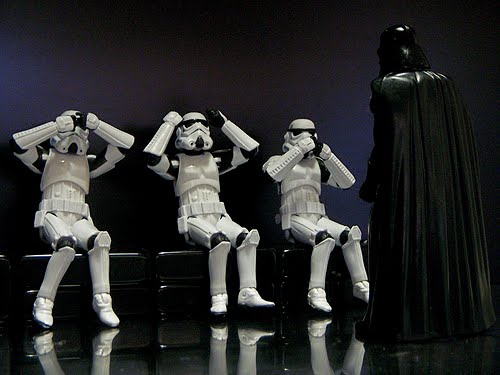This is a continuation of my series on the Starburst Method:
- The Starburst Method: What It Is And What It Can Do
- The Starburst Method: Discovering Your Characters
- The Starburst Method: The Hero's Journey, Part 1
You don't have to read the previous articles to understand this one, though I would encourage you to read The Starburst Method: The Hero's Journey, Part 1 since this is a continuation of that material.
3. Entering The Special World
The Special World is different. We're not in Kansas anymore.
Whatever rules for acting, for getting ahead, your hero knew in the Ordinary World no longer apply. This is a different reality.
A popular way of demonstrating this strangeness is to test your hero with a series of trials, at least one of which he should fail miserably.
Bar scenes are great for demonstrating how alien the Special World is. Of course the setting doesn't have to be a bar, it can be any kind of watering hole, any place where a lot of different kind of folk meet and where it's easy for the crowd to get ... er ... lively. (Think of the bar scene in Star Wars IV.) This is where your hero can get a crash course on the new rules, the new conventions, as well as meet new friends, make enemies and generally get things moving.
Threshold Guardian
I think the concept of a threshold guardian is one of the most useful concepts in my writer's workbox. I suspect different folks think of the Threshold Guardian in different ways, and would give him different attributes, so what I say here pertains specifically to how I think of him.
So, preliminaries aside, what is a Threshold Guardian? Here's how I think of it:
A Threshold Guardian is a force--usually a person--that tries to keep the status quo.
How A Threshold Guardian Operates In A Story
Let's back up a bit. When your hero is still lounging in the Ordinary World he'll receive what a lot of writers refer to as a Call To Adventure. This will be an invitation, a reason, for the hero to leave his current existence, his life as he knows it, and enter the strange wonderland of the Special World.
For instance--and I know I talk a lot about Star Wars IV, but, what can I say? I thought it was a great movie!--Obi-Wan Kenobi gives Luke a clear call to adventure when he invites him to learn the ways of The Force and travel to Alderaan.
Refusal of the Call is common too. Luke says, Thanks but no thanks. I can't go. I have responsibilities. I have to help out my uncle and aunt on their farm. And that's a perfectly good reason.
In a sense (this is what I'm going to argue, you might not agree with me) Luke's uncle fills the role of a Threshold Guardian. Why? Because Luke's uncle does everything he can to prevent Luke leaving the farm. Even Luke's aunt says to the uncle something to the effect: Why don't you just let Luke go? The uncle has the best of reasons, I'm sure, but he is like a jealous dragon guarding his treasure and Luke is on top of the pile.
But many different kinds of archetypes can be involved in a Call To Adventure. For instance, The Mentor. After the hero refuses the call often it's the mentor who gets him back on track. For instance, the Frog brothers in The Lost Boys were unlikely mentors to Sam Emerson. Also, though I won't go into it here, The Shadow and The Trickster can also, in their own distinctive ways, be effective Threshold Guardians.
What's the point?
The Threshold Guardian--regardless of which guise he appears in within your story (The Shadow, The Mentor, The Trickster, and so on)--is going to be a pivotal figure in moving your hero from the Ordinary World into the Special World.
Sure, Luke's uncle never got much screen time, but when it comes to why Luke accepted the Call To Adventure his uncle is the single biggest reason. It was his death, and that of his aunt, that both removed Luke's reason for refusing the call--the farm didn't exist anymore--and gave him a positive reason--avenge his relative's deaths by helping to destroy the Empire and, of course, Darth Vader--for taking up the adventure.
How this would this look: An example
Here's an example using--yes, you guessed it!--Star Wars IV:
1. Ordinary WorldOr something like that! I wrote this example in 15 minutes so I'm sure you can do better. Hopefully you can see what I've been talking about as well as where we're headed.
Whenever there was something that needed fixing around his uncle's farm Luke Skywalker was somewhere else racing his speeder dreaming of adventure.
2. Setting & Friends
Then he met two droids--one snarky and self-absorbed but loyal and the other quirky and full of heart but with a knack for finding adventure--who changed his life ...
3. Special World
... by leading him to mysterious old Ben Kenobi who the droids referred to as Obi-Wan Kenobi.
Obi-Wan Kenobi tells Luke he used to teach his father before his father was killed by a minion of the Emperor: Darth Vader. Obi Wan offers to train Luke in the way of The Force and take him on a quest to save the Rebel Alliance and help defeat Darth Vader and, ultimately, the evil Empire.
Luke would love to accept but he declines because his uncle and aunt need his help to run the farm.
When the Emperor's minions kill Luke's uncle and aunt and obliterate their farm Luke swears vengeance and, taking up his father's lightsaber, asks Obi-Wan Kenobi to be his teacher.
4. It All Falls Apart
When our intrepid band of unlikely adventurers spots an enormous planet destroyer known as the Death Star they come to the attention of the being, now more machine than man, who killed Luke's father: Darth Vader. With their ship impounded, Obi Wan dead and an ungrateful princess on their hands, how will they ever save themselves let alone the rebel alliance?
5. The Challenge
Luke and his not-so-merry band of adventurers have to overcome nearly insurmountable obstacles if they are going to rescue the princess. Can they learn to work together in time to save the rebel alliance, defeat the Empire and save the universe?
I had wanted to get through parts four and five today but it looks like that's not happening! Tomorrow, even if the post is a bit long, I'll get through this Hero's Journey section. Promise!
Update: Here is a link to the next article in this series: The Starburst Method: The Hero's Journey, Part 3. (And I do keep my promise!)
Other articles you might like:
- The Starburst Method: Discovering Your Characters- How To Format A Word Document For Uploading To Amazon
- The Magic Of Stephen King: An Analysis Of The Opening Paragraphs Of The Dead Zone
Photo credit: "See No Vader, Hear No Vader, Speak No Vader" by JD Hancock under Creative Commons Attribution 2.0.





